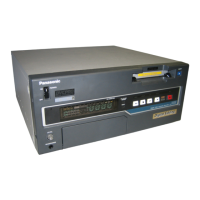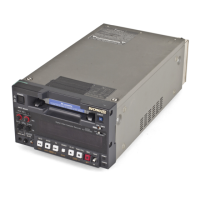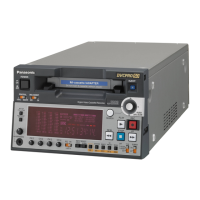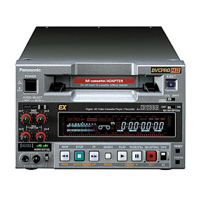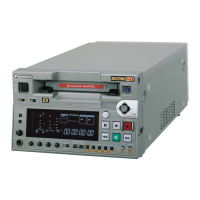Do you have a question about the Panasonic AJ-D450 and is the answer not in the manual?
Details power, operating environment, weight, and dimensions.
Details video/audio bandwidth, S/N, sampling, and quantizing.
Lists specifications for all input, output, and other connectors.
Provides warnings about electrical shock, fire hazards, moisture, and accessory usage.
Offers advice on unit handling, environment, cleaning, and basic maintenance.
Details UK and European plugs, fuse replacement, and correct wiring procedures.
Highlights the importance of earthing the apparatus and not removing panel covers.
Provides precautions on ventilation, magnetic fields, and lithium battery disposal.
Provides guidelines for servicing, including lead dress, protective devices, and leakage current checks.
Explains methods to reduce component damage caused by static electricity.
Details X-radiation sources and necessary safety precautions during service.
Introduces the unit as a digital VTR with compression technology and a compact design.
Highlights recording time, consumer compatibility, slow motion, shuttle, and time codes.
Covers advanced I/O, digital audio, editing functions, and menu-driven setup for AJ-D450.
Details the counter display, status lamps, and cassette indicators.
Explains primary controls for power, tape transport, system settings, and time code selection.
Details controls for audio monitoring, volume adjustment, and input level.
Explains switches for system mode, time code input selection, and menu operations.
Describes cursor buttons used for menu navigation and value adjustment.
Explains the function of buttons controlling tape movement like REW, STOP, FF, PLAY, and REC.
Details controls for audio monitoring, volume adjustment, and input level.
Explains switches for system mode, time code input selection, and menu operations.
Describes cursor buttons used for menu navigation and value adjustment.
Details controls for setting confirmation, diagnostics, input selection, and remote/local operation.
Details analog and digital video and audio input connectors and their functions.
Describes analog and digital video and audio output connectors, plus monitor output.
Details connectors for time code, serial communication, and remote control interfaces.
Details AC power input, signal ground terminal, and fuse holder locations.
Details digital audio and serial digital interface connectors for enhanced connectivity.
Details the types of cassette tapes supported, including consumer, M, and L formats.
Provides cautions for using consumer DV tapes, DVCAM tapes, and operational limits.
Guides setting up the unit for recording and playback using a single device.
Details the setup for recording, playback, and editing between two units (deck to deck).
Illustrates basic system configurations for editing with external controllers.
Depicts system setups for AB roll editing using multiple players and switchers.
Details the procedure for adjusting encoder output controls for accurate AB roll editing.
Guides adjustment of system phase using a waveform monitor for precise signal alignment.
Illustrates printed circuit boards and associated switches for audio and component level settings.
Provides step-by-step instructions for powering on the unit and loading a cassette tape.
Describes entering stop mode, tape protection, and Still Timer settings.
Details the process for selecting input signals, adjusting levels, and starting recording on AJ-D450.
Guides the user through inserting a tape, starting playback, and stopping the playback.
Guides on modifying unit settings and restoring factory default configurations.
Details the procedure for restoring all unit settings to their original factory defaults.
Explains how to manage user files for storing and recalling custom unit settings.
Details how to enable or disable lock mode to protect system and user file settings.
Provides instructions on copying settings from one user file to another for configuration.
Explains how to save current settings into a selected user file.
Explains system settings related to signal phase, encoder functions, and menu lock.
Details the P-ROLL TIME setting for preroll adjustment.
Details settings for character positioning, display selection, and character type.
Explains settings for remote control operation, tape timer, and super display.
Details settings for shuttle and fast forward/rewind maximum speeds.
Explains settings for audio muting and reference signal alarms.
Details capstan lock modes and tape format selection for different cassette types.
Covers EE selections, auto rewind, memory stop, and REC inhibit.
Details configuration for remote control, RS-232C communication speed, and data parameters.
Details settings for signal identification and servo synchronization.
Explains channel assignments for audio presets during editing operations.
Details cue-up modes, memory unit, and variable speed controls for editing.
Details settings for maximum forward and reverse jog speeds.
Explains settings for tape protection modes like still timer and standby operations.
Details VITC signal insertion positions and output selection.
Explains time code generation modes, regeneration, external sync, and user bit settings.
Details time code phase correction, flags, modes, and output synchronization.
Explains video input level, black burst signal generation, color killer, sync, mute, and closed caption settings.
Details closed caption, freeze modes, EDH, and wide aspect ratio signal handling.
Explains settings for composite video input setup and output signal configuration.
Details reference level settings for analog audio inputs and outputs.
Explains audio monitoring selection and input signal routing for recording.
Details cue recording, DV output modes, fade processing, audio embedding, line selection, and signal attenuation.
Details settings for controlling tape travel status during cue track playback.
Explains menu operations for loading, saving, auto-loading, and locking user files.
Explains the function of time code for recording, reading, and editing tape positions.
Describes the user bit function for storing operator numbers and alphanumeric data.
Provides a step-by-step guide for setting and recording internal time codes.
Details the procedure for setting and recording external time codes using LTC or VITC.
Guides on reproducing and displaying time code and user bit values during playback.
Explains display abbreviations and how to customize character appearance and background.
Details how to adjust the position of superimposed characters and display the VTR operation mode.
Illustrates the logic for selecting servo reference signals based on unit mode and input availability.
Presents tables detailing servo reference signal switching based on input status and settings.
Explains automatic cut or fade processing at edit points based on recorded information.
Provides step-by-step instructions for installing the unit into a standard 19-inch rack.
Recommends daily video head cleaning using specified Panasonic cleaning fluid.
Explains condensation causes and procedures for unit recovery from moisture buildup.
Details how to use the DIAG menu to view warning messages and operational hours.
Lists and describes operational hours for power supply, drum rotation, and tape transport.
Explains the priority of errors and how messages are displayed on the counter and monitor.
Lists specific error codes for various malfunctions.
Details error codes related to mechanical issues like reel motors, capstan, and tape loading/unloading.
Introduces RS-232C interface for VTR control and lists command acknowledgment conditions.
Details D-SUB 25-pin connector specifications and example PC connections.
Details communication parameters, speed, data format, and send procedures for RS-232C.
Details VTR return formats, error codes, and their descriptions for communication.
Lists commands for controlling VTR operations like stop, eject, play, rewind, fast forward, record, and shuttle.
Details commands for reverse shuttle operations and setting VTR to standby ON/OFF.
Lists commands for inquiring about counter value, VTR status, and model information.
Presents a sample QuickBASIC program demonstrating RS-232C communication with the VTR.
Details video input and output signals, including digital, analog, and S-Video connections.
Details audio input/output signals, time code connections, and headphone signals.
Details the pin assignments and signals for the RS-422A remote control connector.
Details pin assignments for RS-232C and 15-pin Encoder Remote connectors.
